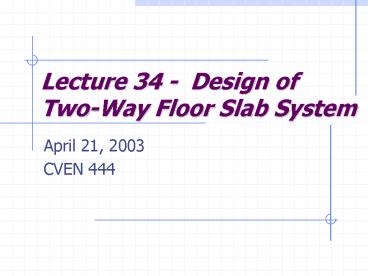Lecture 34 Design of TwoWay Floor Slab System - PowerPoint PPT Presentation
1 / 37
Title:
Lecture 34 Design of TwoWay Floor Slab System
Description:
The critical location is found at d distance from the column, where ... One-way shear considers critical section a distance d from the column and the ... – PowerPoint PPT presentation
Number of Views:276
Avg rating:3.0/5.0
Title: Lecture 34 Design of TwoWay Floor Slab System
1
Lecture 34 - Design of Two-Way Floor Slab System
- April 21, 2003
- CVEN 444
2
Lecture Goals
- Shear Strength of Slabs
- Shear Example
- Direct Design Method
3
Shear Strength of Slabs
In two-way floor systems, the slab must have
adequate thickness to resist both bending moments
and shear forces at critical section. There are
three cases to look at for shear.
Two-way Slabs supported on beams Two-Way Slabs
without beams Shear Reinforcement in two-way
slabs without beams.
1. 2. 3.
4
Shear Strength of Slabs
Two-way slabs supported on beams
The critical location is found at d distance from
the column, where
The supporting beams are stiff and are capable of
transmitting floor loads to the columns.
5
Shear Strength of Slabs
The shear force is calculated using the
triangular and trapezoidal areas. If no shear
reinforcement is provided, the shear force at a
distance d from the beam must equal
where,
6
Shear Strength of Slabs
Two-Way Slabs without beams
There are two types of shear that need to be
addressed
One-way shear or beam shear at distance d from
the column Two-way or punch out shear which
occurs along a truncated cone.
1. 2.
7
Shear Strength of Slabs
8
Shear Strength of Slabs
One-way shear considers critical section a
distance d from the column and the slab is
considered as a wide beam spanning between
supports.
9
Shear Strength of Slabs
Two-way shear fails along a a truncated cone or
pyramid around the column. The critical section
is located d/2 from the column face, column
capital, or drop panel.
10
Shear Strength of Slabs
11
Shear Strength of Slabs
If shear reinforcement is not provided, the shear
strength of concrete is the smaller of
as is 40 for interior columns, 30 for edge
columns, and 20 for corner columns.
12
Shear Strength of Slabs
Shear Reinforcement in two-way slabs without
beams.
13
Shear Strength of Slabs
14
Shear Strength of Slabs
15
Shear Strength of Slabs
Conventional stirrup cages
16
Shear Strength of Slabs
Studded steel strips
17
Shear Strength of Slabs
The reinforced slab follows section 11.12.4 in
the ACI Code, where Vn can not
The spacing, s, can not exceed d/2. If a
shearhead reinforcement is provided
18
Example Problem
Determine the shear reinforcement required for an
interior flat panel considering the following
Vu 195k, slab thickness 9 in., d 7.5 in., fc
3 ksi, fy 60 ksi, and column is 20 x 20 in.
19
Example Problem
Compute the shear terms find b0 for
20
Example Problem
Compute the maximum allowable shear Vu 195
k gt 135.6 k Shear reinforcement is need!
21
Example Problem
Compute the maximum allowable shear So fVn
gtVu Can use shear reinforcement
22
Example Problem
Use a shear head or studs as in inexpensive
spacing. Determine the a for
23
Example Problem
Determine the a for The depth ad
41.8 in. 7.5 in. 49.3 in. ? 50 in.
24
Example Problem
Determine shear reinforcement The fVs per
side is fVs / 4 14.85 k
25
Example Problem
Determine shear reinforcement Use a 3 stirrup
Av 2(0.11 in2) 0.22 in2
26
Example Problem
Determine shear reinforcement spacing Maximum
allowable spacing is
27
Example Problem
Use s 3.5 in. The total distance is 15(3.5
in.) 52.5 in.
28
Example Problem
The final result 15 stirrups at total distance
of 52.5 in. So that a 45 in. and c 20 in.
29
Direct Design Method for Two-way Slab
Method of dividing total static moment Mo into
positive and negative moments.
Limitations on use of Direct Design method
- Minimum of 3 continuous spans in each direction.
(3 x 3 panel) - Rectangular panels with long span/short span
2
1. 2.
30
Direct Design Method for Two-way Slab
Limitations on use of Direct Design method
Successive span in each direction shall not
differ by more than 1/3 the longer span.
3. 4.
Columns may be offset from the basic rectangular
grid of the building by up to 0.1 times the span
parallel to the offset.
31
Direct Design Method for Two-way Slab
Limitations on use of Direct Design method
All loads must be due to gravity only (N/A to
unbraced laterally loaded frames, from mats or
pre-stressed slabs) Service (unfactored) live
load 2 service dead load
5. 6.
32
Direct Design Method for Two-way Slab
Limitations on use of Direct Design method
- For panels with beams between supports on all
- sides, relative stiffness of the beams in the 2
- perpendicular directions.
- Shall not be less than 0.2 nor greater than 5.0
7.
33
Definition of Beam-to-Slab Stiffness Ratio, a
Accounts for stiffness effect of beams located
along slab edge reduces deflections
of panel adjacent to beams.
34
Definition of Beam-to-Slab Stiffness Ratio, a
With width bounded laterally by centerline of
adjacent panels on each side of the beam.
35
Two-Way Slab Design
Static Equilibrium of Two-Way Slabs
Analogy of two-way slab to plank and beam
floor Section A-A Moment per ft width in
planks Total Moment
36
Two-Way Slab Design
Static Equilibrium of Two-Way Slabs
Analogy of two-way slab to plank and beam
floor Uniform load on each beam Moment in one
beam (Sec B-B)
37
Two-Way Slab Design
Static Equilibrium of Two-Way Slabs
Total Moment in both beams Full load was
transferred east-west by the planks and then was
transferred north-south by the beams The same is
true for a two-way slab or any other floor system.































